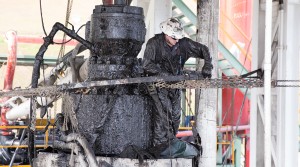After criticizing Pa.’s radiation study, oil and gas industry launches its own
-
Marie Cusick

Lindsay Lazarski/WHYY
A drill worker covered in mud, shale, and drill cuttings at a site in Susquehanna County. The DEP began its year-long study into radiation associated with oil and gas development in April.
After criticizing an ongoing study by the state Department of Environmental Protection, two organizations representing Pennsylvania’s oil and gas industry are launching their own review to examine the radioactive materials associated with their work.
The DEP began its year-long study into the issue in April.
“We are continuously driven to get safer, more efficient, and smarter across all our operations,” says Travis Windle of the Marcellus Shale Coalition, a trade group representing the gas industry.
Windle says this is not an attempt to undermine the work of the department, but rather an effort to bring sound science to guide policy decisions.
The DEP is focusing on the quantity of naturally occurring radioactive materials (NORM) and technologically enhanced naturally occurring radioactive materials (TENORM).
NORM can become TENORM when materials are mixed together, moved, or otherwise changed.
Although the DEP says it’s unlikely there is a threat to public health, concerns about radioactivity associated with oil and gas development persist.
A study published last month in the journal of Environmental Science and Technology found high levels of radiation and salinity in a creek near a drilling wastewater treatment facility in western Pennsylvania.
The Marcellus Shale Coalition and the Pennsylvania Independent Oil and Gas Association (PIOGA) say their radiation review is “intended to augment the DEP study.”
In August, the two industry organizations submitted a lengthy critique to the DEP arguing, among other things, that the design of the department’s study was flawed.
“The study is not likely to be considered comprehensive due to the limited number of samples to be collected,” the organizations wrote to the DEP. “The industry has concerns that the study is targeting ‘known’ sites with evidence of elevated radiation levels.”
In response the DEP agreed to expand the sample size, but said the total number of sampling sites will not be determined until the end of the project.
The industry organizations also asked if they would be able to review the DEP study before it’s independently peer-reviewed and released to the public.
The DEP said they won’t.
















